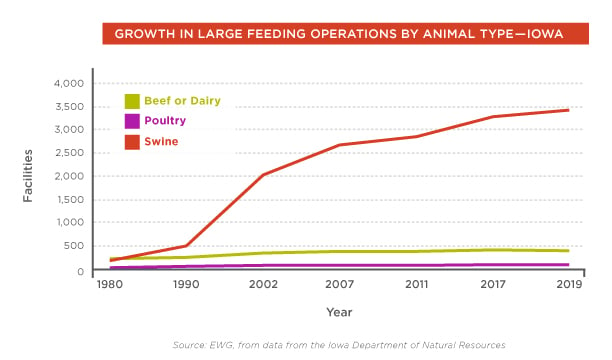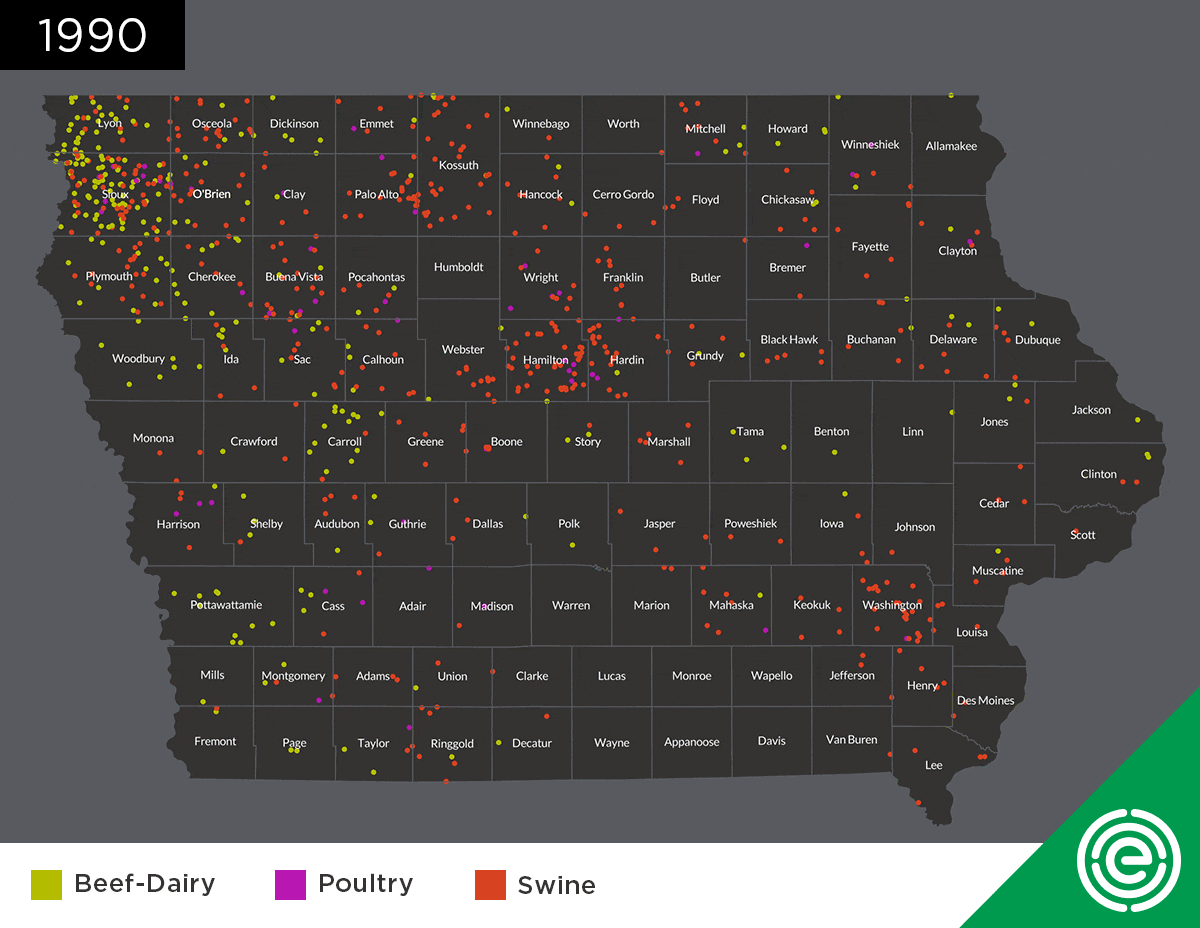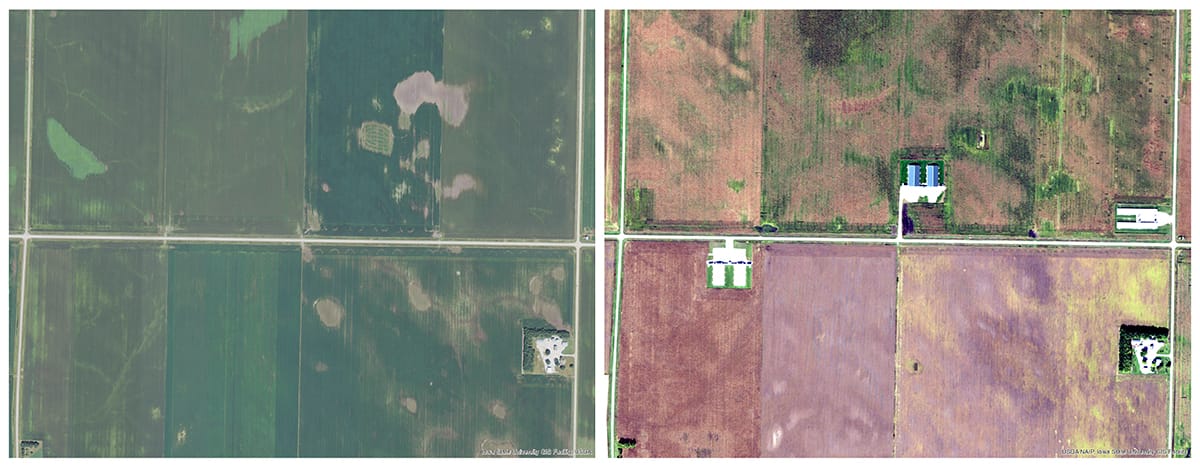Methodology for Dating Large Animal Feeding Operations in Iowa
By Sarah Porter, Senior GIS Analyst, and Soren Rundquist, Director of Spatial Analysis
Special thanks to EWG intern Jack Acomb.
Overview
EWG used high-resolution aerial photography and satellite imagery to analyze large animal feeding operation growth in Iowa between 1980 and 2019.
Data
The Iowa Department of Natural Resources, or DNR, maintains a database of animal feeding operations, or AFOs, permitted in the state. Iowa tracks data on two types of DNR-regulated AFOs, both of which house animals kept and fed for 45 days or more per year: confinements and open feedlots. The DNR publishes this information as attributed point locations. EWG downloaded these data from the Iowa Geodata website on July 30, 2019.
The dataset included general information for 12,358 operations, including but not limited to: facility name, facility status, facility location and number of animal units of each animal type. An animal unit is defined as an animal equivalent of 1,000 pounds live weight, with a single animal unit equating to 1 beef cattle, .7 dairy cattle, 2.5 swine weighing more than 55 pounds, 125 broiler chickens, or 82 laying hens or pullets.1
Active Operations with Dominant Animal Type
Three hundred and seventy-two facilities had no animal units listed for the dominant livestock groups and were removed from the analysis, leaving 11,986 facilities with detailed information on animal type and animal unit count. Before dating analysis began, the data were subset to extract all active operations housing a dominant livestock group, including poultry (chickens and turkeys), swine, beef cattle and dairy cattle. For facilities housing multiple livestock types, EWG identified the dominant livestock type at each facility.
Large Operations
EWG tracked new and expanded large concentrated animal feeding operations, or large CAFOs, defined as any facility that confines at least 1,000 animal units.2 Iowa DNR requires a construction permit for any facility that will confine livestock equivalent to 1,000 or more animal units.
The final count for large, active animal feeding operations to be dated included 3,955 operations.
Historical Imagery
The DNR maintains a large collection of statewide aerial photography, dating as far back as the 1930s. EWG used this collection of aerial photography, along with recent satellite imagery from Planet, to document the history of CAFO construction in Iowa between the 1980s and 2019. Each CAFO housing 1,000 or more animal units was analyzed at seven time stamps, listed below, along with the source of imagery used:
- 1980s – color infrared aerial photography: 1-meter horizontal resolution.
- 1990s – aerial orthophotography: 1-meter horizontal resolution.
- 2002 – color infrared aerial photography: 1-meter horizontal resolution.
- 2007 – National Agriculture Imagery Program, or NAIP, aerial photography: 2-meter horizontal resolution.
- 2011 – NAIP aerial photography: 1-meter horizontal resolution.
- 2017 – NAIP aerial photography: 1-meter horizontal resolution.
- 2019 – Planet (PlanetScope) satellite imagery: 3-meter horizontal resolution.
Facility Attribution
Several attributes were recorded for each facility, including the year the facility was first observed in imagery and years of expansion, if any. A facility expansion included the addition of or increase in size of livestock barns, or in the case of cattle, the addition of or increase in size of feedlots or paddocks. Expansion also included an increase in facility infrastructure, such as the addition of a lagoon or manure holding tank. Facility attribution was performed using the best judgment of the geographic information system analyst. An additional round of quality control was performed by a separate reviewer.
Nineteen facilities could not be located on any imagery from any of the time stamps, and were therefore removed from the dataset. In total, EWG successfully dated 3,936 large AFOs in Iowa – 99.5 percent of the total number of operations. Reasons for being unable to date a location could include that the facility had not yet been built or was mislocated, or some other recording factor.
Although these facilities account for only a third of Iowa’s AFOs, they contain 62 percent of the animal units from all regulated operations.
Waste Calculation
To estimate animal waste output for a year, the DNR data were used to identify the large operations housing 1,000 or more animal units and the corresponding animal type. These units were then converted to animal counts and given a daily waste estimate, which was then multiplied by 365 to model a year. General assumptions were made for each animal type to streamline the calculation.
|
Waste Estimation Assumptions*
|
|
Iowa DNR Primary Animal Type
|
Animal Unit Converstion
|
General Animal Type
|
Animal Size (in Pounds)
|
Daily Waste Output (in Pounds)
|
|
Beef
|
1
|
Finishing cow
|
750
|
37
|
|
Dairy
|
0.7
|
Lactating cow
|
1,000
|
111
|
|
Poultry**
|
82
|
Layer
|
3
|
0.15
|
|
Swine
|
2.5
|
Finishing pig
|
150
|
7.4
|
|
* Animal type, size and total manure by pounds, from the 2004 Midwest Planning Service
|
|
|
|
|
* Chicken and turkey animal units combined
|
|
|
|
|
|
2019 Waste Estimate
|
|
Animal Type
|
Animal Count
|
Waste Per Day (in Pounds)
|
Waste Per Year (in Pounds)
|
|
Beef
|
1 million
|
38.3 million
|
14 billion
|
|
Dairy
|
0.2 million
|
22.1 million
|
8.1 billion
|
|
Poultry
|
73.4 million
|
11 million
|
4 billion
|
|
Swine
|
15.7 million
|
116.2 million
|
42.4 billion
|
|
Total
|
90.3 million
|
187.6 million
|
68.5 billion
|
References
- 1 States Department of Agriculture Natural Resources Conservation Service. Animal Feeding Operations. https://www.nrcs.usda.gov/wps/portal/nrcs/main/national/plantsanimals/livestock/afo/
- 2 1,000 animal units is equivalent to 2,500 hogs, 1,000 cattle, 700 dairy cows or 82,000 laying hens. For more information on animal units in Iowa click here: https://www.lawserver.com/law/state/iowa/ia-code/iowa_code_459-102












